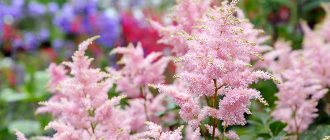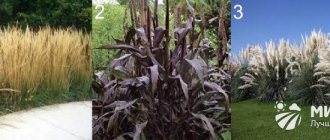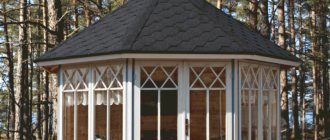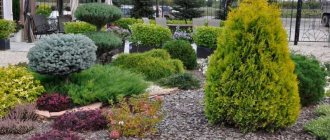Helpful information
Lavender is native to areas with warm climates.
To ensure that it blooms beautifully and survives the winter well, varieties that are frost-resistant are selected. Mediterranean varieties are unlikely to survive the cold temperatures of winter.
General description of the plant:
| Characteristic | Peculiarities |
| Root system | Woody, strong, with a developed core system of branches, which are located in the upper layer of soil |
| Foliage | Opposite-sessile, oblong-linear, with a rolled edge. The leaves are densely pubescent, grayish-green. Can reach up to 6 cm in length |
| Inflorescences | Spike-shaped, located at the top of the stems |
| Fetus | Consists of 4 nuts that are attached to the calyx of the flower |
In order for the landscape design to be beautiful, you will need care and quality care.
Before you start decorating with lavender, you need to consider the following:
- The survival rate of the selected species to the environment.
- The plant has a wide variety of varieties. These are tall and low growing species from which you can choose, combine them, and use them for different ideas. Lavender can be used to decorate garden paths and organize hedges with its help.
- The plant blooms in the second half of the summer season.
- Not all types of flowers have beneficial properties.
- For good development, sandy loam soil is more preferable.
- Possible methods of propagation are cuttings, seeds. Growing lavender from seeds is very difficult and labor-intensive. And for cuttings, planting material is cut only from bushes that have reached 3 years of age
To obtain a beautiful landscape design using lavender, you will need care and quality care.
Varieties
One of the main differences between lavender varieties is the shade of flowering. The association of many beginners with the plant is a purple cloud. This is not entirely true. There are blue, pink, greenish tones of flowering
Basically, lavender is divided by professionals into the following types:
1 English
English angustifolia lavender
This variety has other names:
- narrow-leaved (Lavandula angustifolia)
- spica (Lavandula spica)
- officinalis (Lavandula officinalis)
It has narrow foliage and longer inflorescences. Very often used for design decoration of territories. It has good winter hardiness and rapid development. This class does not require digging up the plant for the winter.
The most favorite varieties include:
- Alba
Enchanting abundance of white blooms. It is characterized by rapid, problem-free growth even in areas with cold climates.
- Beechwood Blue
Captivates with its lilac-blue blooms. Has good frost resistance. Winters well in open ground without the need for digging.
Lavender Rosea
- Rosea
It has purple-pink inflorescences and cute fibers on them.
- Gem
Characterized by abundant bright purple blooms. It is often used for organizing living fencing.
The plant, which has a miniature size, is used year-round for interior decoration. The most popular varieties are:
- Nana Alba
- Little Lottie
They are planted in flower pots and placed on windowsills.
2 French
French broadleaf lavender
Latin name Lavandula latifolia (broad-leaved lavender). Characterized by wider foliage with short peduncles.
Characterized by capriciousness. Cannot be outdoors in winter. It is most often used in interior decoration.
Popular varieties include:
- Tiara
- Rocky Road
- Helmsdale
3 hybrid
Hybrid (Dutch) lavender
May also be known as Dutch lavender (Lavandula x intermedia). It is a hybrid of narrow-leaved and broad-leaved lavender.
Grown in industrial production. It has impressive dimensions in height (up to 2 m). It begins to bloom in mid-summer. Characterized by a variety of flowering shades.
Popular varieties:
- Richard Gray (dark purple inflorescences)
- Grosso (purple bloom)
- Alba (snow-white buds)
It will look spectacular in a flower bed with pink roses.
4 serrated or spanish
Jagged (Spanish) lavender
Serrated lavender is not at all frost-resistant. Excellent for growing in areas with warm climates or for indoor conditions. The bush is compact. Silvery patterned foliage.
The flowers are large and fragrant. The smell is pleasant, delicate, between lavender and rosemary. The blooms are excellent with varying shades of purple.
Currently, there are about 47 species of lavender in the natural environment. They differ in the shape of foliage, inflorescences, size of shrubs, resistance to low temperatures, and pests.
Also, more than 40 varieties have been artificially created , but only a small number of them have beneficial properties.
5 multi-incision
Multi-cut lavender
Latin name Lavandula multifidi (multicut lavender). The herbaceous shrub is a heat-loving, unpretentious species. It reaches a height of 60 cm.
In the central zone it is grown as an annual plant. Flowering lasts all summer and until late autumn. Color blue-violet.
Popular varieties:
- Southerner
- Stekhadskaya
Types and varieties of lavender with photos and names
Today, gardeners cultivate only broadleaf and angustifolia lavender. Below we will also describe those types of lavender that can also be grown in your garden.
French lavender (Lavandula stoechas)
Or broadleaf lavender (Lavandula latifolia). The homeland of this species is South-West Europe. The scent of the spectacular lavender flowers is very strong; they can be colored in various shades of pink, green, white, purple, lilac or burgundy. This lavender blooms somewhat earlier than other types, and this happens in April–May. Flowering ends in July, but sometimes in the last summer weeks the bush blooms again. Compared to narrow-leaved lavender, this species is not as frost-resistant; therefore, it is cultivated mainly in regions with warm and mild climates. The most popular variety among gardeners is Lavandula stoechas pedunculata, or “butterfly” (Papillon): the flowers of this shrub have an unusual, spectacular shape. The best varieties of lavender are:
- Yellow Vale. The foliage of the shrub is greenish-yellow, the flowers are dark purple, and the bracts are crimson.
- Regal Splendur. The flowers are dark purple.
- Rocky Road. This variety appeared relatively recently. Its large, bluish-purple flowers open in July.
- Tiara. The bracts of the large blue flowers are cream colored.
- Helmsdale. The flowers are burgundy-lilac.
Lavender hybrid (Dutch)
This group of highly decorative hybrids was created using English lavender and other species of the genus. Such a large shrub is decorated with narrow silvery leaf plates, as well as large oblong flowers located on long peduncles that bend under their weight. It blooms in July. The best varieties include:
- Alba. The flowers are painted white.
- Arabian Knight. The color of the flowers is dark purple or dark blue.
- Sawyers. The color of the flowers is pale lilac.
- Grosso. Large beautiful flowers are colored lilac-violet.
- Richard Gray. The compact bush is decorated with dark purple flowers.
Toothed lavender (Lavandula dentata)
This species is native to the Mediterranean. It is a compact shrub that is thermophilic. The silvery leaf plates are rugged and soft. Flowering occurs in July, during which large fragrant flowers open. The species is not highly resistant to frost. The most popular variety among gardeners is Royal Crown: the flowers are purple.
Lavender angustifolia (Lavandula angustifolia)
Either English lavender (Lavandula spicata) or medicinal lavender (Lavandula officinalis). This shrub is native to Southern Europe. This perennial is decorated with greenish-silver foliage and small lilac-blue flowers. Flowering begins in July–August. This species differs from others in that it has the highest resistance to frost. The most popular variety of this shrub is delphinium lavender: the height of the bush is no more than 0.3 m, it is decorated with very impressive silver-colored leaves. Hidcoat lavender is also widely cultivated, most often it is used to create not very high hedges. The best varieties include:
- Alba. Half-meter bushes are decorated with white flowers.
- Rosea. A low shrub, reaching a height of about 0.4 meters, forms mauve inflorescences during flowering.
- Manstead. Bright blue flowers bloom on a bush that reaches a height of 0.4 meters.
- Hidcoat Giant. The height of such a compact shrub is approximately 0.6 m.
- Hidcoat Blue. Purple-blue flowers adorn the compact plant, which reaches a height of about 0.4 m.
Lavandin
Lavandin
Among the descriptions of all types, it deserves a separate point. It is a hybrid species of true and broadleaf lavender (Spike Lavender). Began to be grown in 1920. This was influenced by economic factors.
The main beautiful differences between lavandin and real lavender:
- Abundant and prosperous growth on lower areas of land (400-600 m), i.e. For cultural cultivation, the plant is an easier species.
- Higher yield levels. The volumes of the obtained essential oil are much larger and the cost is cheaper.
- Less susceptibility to pests and diseases.
- Greater efficiency of decorative qualities, namely greater durability, sharpness of aroma, brightness of violet-blue flowering
Lavandin has lower consumer qualities. The chemical composition does not allow the plant to be used for medicinal purposes in unlimited possibilities. This also applies to essential oils. It cannot be fully used in aromatherapy. Lavandin oil cannot also be used for burns.
Lavandin
Since lavandin has a longer, stronger aroma, using it in a bouquet, laundry sachet, or soap will not cause any problems. For medicinal, aromatherapy, food and cosmetic purposes, it is recommended to use lavender essential oil.
Lavender varieties
Lavender has 20 varieties, the most common:
- Broad-leaved (French) - 130 centimeters in height, has a bright aroma. It is not winter-hardy, so it should not be grown in open ground.
- Toothed - a small shrub up to 30 centimeters in height. This species is distinguished by its decorative value and is grown only in pots.
- Narrow-leaved - also known as medicinal. Frost-resistant, so it can be grown in central Russia.
Landing
Favorable places for planting are areas with good sunlight
As mentioned above, before planting, you need to choose a flower variety that will be more adapted (i.e., will not suffer from ambient temperature, humidity) to the climatic conditions of the area.
It is better to plant lavender in sunlit areas. As for the soil, for good development and full flowering, preference is given to sandy loam alkaline soils. To loosen very dense soil compositions, wood ash and lime are additionally added.
In spring, planting begins after the frosts have completely disappeared. For the southern regions, where the winter period is mild, planting is possible in the autumn season in 40-50 days. before frost sets in.
There are several ways to grow lavender:
- seeds
- cuttings
- layering
They usually choose based on whether there is already a bush with a strong root system on the territory or whether the plant is going to be grown for the first time.
Growing Lavender
Growing lavender from seeds is a long process. It begins with the stratification of the material in an artificial way, i.e. The seeds are kept in the cold. To do this, they are mixed in a container with sand, covered with polyethylene and put in the refrigerator for 1.5-2 months.
At the end of the spring season, the material is sown in a greenhouse, a box, where sand is added. With regular moisturizing, everything is kept for another 1 month. Only after all this work has been carried out, the seeds can be placed in open space.
It will take 1-2 years to wait for the first flowering, because... At first, the seedlings will actively grow their root system. Sowing seeds directly into open ground is possible only for areas with warm climatic conditions.
Cuttings are similar to cloning an existing flower. The work begins in spring or summer after the lavender has faded. It must be taken into account that rooting will take approximately 1.5 months.
Young shoots or old ones with young leaves are selected for cutting. They are cut with a knife just below the point from which the leaf (leaf node) grows. The length of the cuttings should be about 6 cm. The prepared material is freed from the lower foliage, dipped in a preparation that stimulates the formation of roots (for example, Kornevin) and planted in a container buried along the upper leaves.
Perlite
Required soil composition for cuttings:
- compost – 1 part
- universal primer – 1 part
- perlite – 1 part
For propagation by layering, material is prepared from an adult plant. For this task, a slightly woody branch is selected. A cut is made in the middle using a sharp knife.
The place with the incision is placed in the ground and sprinkled with earth on top. After 14 days everything is carefully checked for the presence of roots. It will be possible to separate the cuttings from the mother bush and plant them separately when the roots are formed in sufficient quantities.
When planting, it is desirable to preserve the earthen ball on the roots
It is possible to sacrifice a lavender bush for the sake of planting material, provided that the age of the flower has already reached 3-4 years.
To avoid the death of a plant during propagation or replanting, certain conditions must be met:
- the landing pit must have a recess of at least 30 cm
- preservation of the earthen coma on the roots
- use only good soil composition for backfilling
- mandatory covering with mulch (compost, rotted leaves, substrate)
- maintaining the gaps between the bushes, which should be equal to the largest height of the flower
- the base of the trunk should not be covered with soil, which will protect it from rotting
Lavender planting and care in open ground
Beneficial properties of wild rose, how to use rosehip for beauty and health
Before planting a bush in open ground, you need to choose a place for it. It should be borne in mind that soil with high humidity is not suitable for lavender, as the plant will constantly get sick and may die. After the planting site has been selected, fertilizer - wood ash or lime - will need to be added to the soil.
Growing and propagating lavender at home is difficult; the easiest and fastest way is to buy a ready-made seedling and transplant it immediately into open ground.
- The purchased seedling should be placed in water for 60–90 minutes.
- Prepare the beds, which should be 20–40 centimeters high.
- Before planting, the top of the plant must be cut off so that new shoots can quickly develop.
- If the seedling has a lot of roots, they should also be removed a little.
- The distance between the bushes should be at least 30 centimeters, but this is at the request of the gardeners, since if you plan to grow a “carpet” of lavender, then this distance should be less than half that.
Lavender care
Lavender is unpretentious in care, it tolerates drought well and practically does not get sick, but, like any plant, it requires standard procedures: loosening the soil, watering, pruning faded flowers and proper preparation for winter; replanting is not required. But even though the plant is unpretentious, you should still know, especially for beginners, how to properly grow lavender and how to care for it.
- The bush should be planted where the sun shines well, as lavender flowers quickly fade in the shade.
- Lavender requires proper watering, as the plant does not tolerate large amounts of moisture, so it should be watered only when the soil is dry.
- To make the plant bloom longer, you need to trim off faded flowers.
- It is imperative to hill up the lavender or simply loosen it so that oxygen reaches the roots.
- The plant should be fed with fertilizer during the flowering period using mineral fertilizer complexes or nitrogen fertilizers.
- In order to prepare lavender for winter, you need to prune the branches of the bush with faded flowers a little in the fall, then insulate the bush by covering it with coniferous branches on top.
Lavender: planting and care in the Moscow region and Moscow
In order to grow lavender in a country house or in a garden in the Moscow region, you need to know that only narrow-leaved or medicinal lavender is suitable for these purposes. The plant is planted at the same time as in warmer regions of Russia and the care is accordingly the same. The only difference is that it is better not to sow the seeds of the plant before winter, as they may freeze.
How to grow lavender
Care instructions
Pruning is the most important stage of care
High-quality care for perennial flowers means the following work:
- loosening
- weeding
- covering with a mulch layer
- watering
- pruning
- preparation for winter
It is necessary to regularly loosen and mulch the soil due to the nature of the roots , which require good air circulation when the soil composition is loose. Young bushes are especially sensitive to watering.
Overfilling is not advisable. It can result from rotting roots and yellowing of foliage.
Watering lavender
You need to feed lavender when it begins to bloom. To better prepare the plant for the winter, it is better to stop fertilizing by the end of the summer season. A good, thin layer of mulch makes the use of fertilizer unnecessary.
Another important stage of care is pruning the bushes. It must be done when flowering ends. With its help, a beautiful flower shape is formed and better prepares it for winter.
Given the likelihood of a strong drop in temperature in winter (below -250C), all varieties of lavender, even those with good frost resistance, need to be covered. The most suitable shelter is pine branches.
Landing place
The right location is an important condition for the successful cultivation of this crop. Since lavender loves sunlight, the area for planting it should be well lit, ventilated and at the same time be away from water, be it any pond or high groundwater. It is best to choose a place on a hill.
The soils chosen are moderately fertile with low acidity and loose. To optimize growing conditions, peat or compost is added to the hole before planting, and in case of high acidity, lime or ash is added. To ensure good circulation of air and moisture, drainage is installed.
Lavender is propagated using seeds and cuttings. Let's look at both of these methods:
Planting cuttings is a simple task. Take several cuttings and dig them into moist soil to a depth of 5-7cm, then cover and arrange regular watering. When the weather warms up, the cuttings open and their rapid growth begins.
Planting lavender with seeds is more difficult than with cuttings and layering, but this activity only attracts experienced gardeners
Planting seeds is more difficult. The seeds are stratified and planted in a box with soil. For them to germinate, the box is placed in a warm and well-lit place. After germination, lavender is planted in the ground. This usually happens at the end of May. With this method of planting, flowering occurs only in the second year, but it is abundant.
Diseases, pests
Slobbering Penny
Lavender bushes contain phytoncides, and their blooms have a strong aroma, so they are almost not susceptible to diseases or attacks from harmful insects.
The only pest that the plant cannot protect itself from is the slobbering pennitsa. This is a small cicada. It leaves a white foam on the foliage and uses plant sap as nutrition. They fight the pest by treating the leaves with garlic infusion.
Due to improper watering or waterlogging, the stems and root system can darken and become covered with rot. Affected bushes are dug up and burned.
Preparatory work for winter
Cover with spruce branches
After the spikelets fade, they are pruned, keeping 10 cm above the ground. If necessary, seeds are collected before pruning.
Next, the plant is watered with mullein solution and covered. Agrotextiles and spruce branches are used for shelter. Heat-loving species are transferred in containers to warm rooms.
Possible design ideas
Growing Lavender
Lavender has versatility, which makes it possible to use it in the flower garden to create a wide variety of compositions. It will look great anywhere.
The most successful combinations of lavender bushes in the garden will be discussed below.
Alpine slide
Alpine slide
Alpine hill The natural environment of lavender is rocky terrain. For this reason, it will develop excellently and look gorgeous in such places, namely on an alpine hill, rock garden. The tenderness of the bushes located between the stones will, like an airy cloud, enliven everything around you.
Mixborder
Mixborder
Mixborder Lavender bushes can feel great in garden design next to a wide variety of plants. The main condition is that these neighbors do not block the sun, because... the absence of light will depress and deplete the plant. Lavender will have a very original look if you plant red poppies and blue sage next to it as a background.
Lavender also goes best with the following shades:
- pink
- yellow
- white
- bright purple
- orange
- blue
Border
Border
Border A sophisticated, charming arrangement of lavender bushes in a soft lilac shade is created in borders. Everyone, walking along such beautiful garden paths, will receive real pleasure and tranquility from the enveloping delicate aroma.
When creating borders with lavender, you will need to trim the plant regularly to keep it looking picturesque.
Combination with roses
A good combination with roses
Combination with roses This fragrant beauty goes best with roses.
Delicate purple spikelets, enveloping large rose buds, will create a harmonious look in flower beds in the sunniest corners of the garden.
Solitaire (single) plantings
Group planting is like a purple cloud
Solitaire (single) plantings With a huge number of amazing combinations of lavender with other flowers, there is also an excellent option - growing the plant in independent plantings.
Lavender bushes in a group planting, like a purple cloud, will ideally complement a well-groomed lawn, creating colorful islands of vegetation against the backdrop of a green carpet.
Growing in closed containers
Growing in a closed container
Growing in closed containers Lavender bushes planted in containers look very gentle and sophisticated in themselves.
And if you use pots with an unusual design or a unique design as containers , this will allow you to create the greatest creativity in the overall image.
Slope landscaping
Slope landscaping
Gardening of slopes To strengthen the slopes, many gardeners practice growing the following plants:
- loosestrife
- veronica
- rhododendron
- juniper
If you plant lavender between them, this can give the slope an absolutely exclusive look.
Flowerbed combined with herbs
Herb garden
Flowerbed in combination with herbs Arranging a fragrant composition at the dacha is not difficult. To do this, you will need to plant the following herbs next to the lavender:
- dill
- thyme
- rosemary
The good proximity of the culture to various companions provides great opportunities for the manifestation of imagination in creating a fragrant cloud. This corner will appeal to all household members who come and relax here.
Hedge
Beautiful decoration near the fence
Hedge To create a hedge, tall varieties of lavender are used. They will be at least 70-80 cm in height. Favorite varieties include:
- Hidcote Giant
- Melissa Lilac
- Vera
With such a decoration you can not only decorate your summer cottage, but also scare away harmful insects that do not like the lavender scent.
Tall lavender looks equally beautiful near a fence and for dividing an area into zones.
Friendship with the vegetable garden
Natural "enemy" of insects
Lavender is a very useful plant for the garden. It is a natural “enemy” of insects due to the aroma it emits when flowering.
With its help, beauty is created in the beds, and also contributes to the collection of environmentally friendly harvests of garden crops.
Planting fragrant lavender bushes next to potato plantings prevents the appearance of the Colorado potato beetle.
Beautiful indoor plant
Beautiful and fragrant decoration not only for the garden, but also for the home
To grow lavender bushes at home, use purchased plants.
When choosing a future pet, you should carefully examine it. Foliage and stems should be free from damage and insects. The root system should be clearly visible and light. Roots hidden in the ground indicate a recent transplant. In such a situation, it is unknown whether the plant will take root.
For the first few days after purchase, the flower should stand in a sunny place. He will need proper care. Afterwards it must be transplanted into a larger pot. Drainage is poured at the bottom, and sand and peat are placed on top. The transplanted plant is watered with the addition of fertilizer.
Further care for the flower is the same as for a plant grown in open ground.
Autumn is a dormant period for lavender. At this time, watering and fertilizing are reduced. The plant is moved to a cooler corner and lightly pruned.
How to plant lavender seeds
If there is no place to purchase cuttings and grown seedlings, you can try to grow young plants by seed.
To do this, you need to purchase planting material from a trusted seller, and be sure to look at the expiration date of the seeds. Too old specimens will not be able to germinate and will also produce weak shoots. Having purchased the appropriate products, you can get to work. First of all, it is necessary to subject the seeds to stratification. To do this, they are mixed with sand and placed in the refrigerator. The seeds must stand for at least one and a half to two months, after which they are ready for planting. The natural method of stratification involves planting seeds in autumn and hardening them in winter. In the spring, the surviving sprouts are planted, because they have passed the test and received the necessary hardening.
Propagation of lavender by seed includes:
- Soak the seeds in a stimulating solution for about a day.
- Planting in a pre-prepared nutrient mixture.
- The seeds are planted quite densely, so after germination they need to be thinned out.
- The container with seeds must be placed in a warm and well-lit place, covered with glass or thick film.
- After the first two or three leaves appear, the cover is removed and the crops are thinned out.
- Picking seedlings into separate cups occurs about a month after emergence.
- The seedlings are moved to a permanent place of growth after sufficiently warm weather has established (approximate values from 15 degrees Celsius).
In the first year after planting, the sprouts will not bloom, but will only grow stronger and gain height. In the second year of cultivation, it is necessary to pinch the central shoots with the first heat so that the plant forms a lush shape. Further care comes down to regular but moderate watering, weeding and harvesting.” The shoots must be cut during the flowering period, then they are dried and used for the selected purposes.
The secrets of successfully growing lavender can also be learned from our video.
Fragrant lavender, the planting and care of which in open ground are discussed in our article, has a unique composition and benefits for our body. This fragrant plant does not have a capricious character and is suitable for growing not only in the garden, but also as a house pet. What conditions are necessary for this plant, as well as the main secrets of planting and caring for lavender are covered in the information provided.
Application
A priceless gift of nature
Lavender bushes are a priceless natural gift. The culture is widely used by cosmetologists, pharmacists, perfumers, and culinary specialists for its beneficial properties.
In folk medicine, narrow-leaved lavender is used. It has the following properties:
- regenerating
- bactericidal
- antiseptic
Lavender flowers are used to make oils. They are added to solutions for inhalation and to medications for the prevention of influenza.
Cosmetological lavender oil is used in skin and hair care products (shampoos, creams, balms). It provides protection, nutrition, strengthening.
Uses of lavender
Broad-leaved and medicinal lavender is used in cooking. It is added when preparing sauces, soups, fish dishes, and smoked meat. Lavender flowers are brewed in healing infusions and tea.
Lavender during flowering fills everything around with a wonderful aroma. It creates a beautiful view in parks and gardens. The swaying of lilac-violet flowering bushes in park areas is like waves that scatter along the paths. She creates magical images of landscapes, captured by numerous artists and photographers around the world.
Lavender bushes in landscape design can create beautiful, irresistible compositions. In addition, the plant is unpretentious in care. Using these bright flowers in your garden will amaze you with its original, light Mediterranean look.
Using a little imagination will help you easily find suitable companions for the plant, and simple recommendations from professionals will suggest the most suitable place for planting, where lavender will quickly and easily grow, develop, and delight everyone around with its appearance.
Growing lavender from seeds
Growing lavender from seeds is not so easy, moreover, it will take quite a lot of time. Therefore, you first need to decide on the timing of planting and lay the seeds for stratification.
Sowing time
You can sow lavender seeds both in spring and autumn, just calculate the time for stratification in advance. For example, plant the seeds for stratification in January, so that you can sow them in pots in March, and plant lavender seedlings in open ground in May.
Stratification
Lavender seeds require mandatory stratification, in other words, the seeds must be kept for some time at low temperatures and in a humid environment. This is done, firstly, with the aim of creating natural conditions under which the seeds germinate. Secondly, this triggers embryonic sleep, that is, when the temperature drops, the seeds fall asleep, and as soon as it starts to rise, they immediately wake up. Thirdly, this is a kind of shock therapy.
Methods for stratifying lavender seeds:
In wet sand
- Take the sand, then you need to sift it, rinse it and bake it in the oven for 30-40 minutes.
- Pour sand into a bowl and moisten it with a spray bottle (the water should preferably be melted or settled).
- Sprinkle lavender seeds onto the surface of the damp sand.
- Sprinkle a little dry sand on top.
- Place the bowl in a bag and wrap it around the container.
- Place the container in the bottom drawer of the refrigerator (where the temperature fluctuates between +3...-+5 degrees) for 1-2 months.
On cotton pads
- Take a small lid and a couple of cotton pads.
- Place 1 cotton pad on the lid and moisten it with a spray bottle.
- Sprinkle the seeds onto a damp cotton pad.
- Cover the top with a second cotton pad and spray again from the spray bottle.
- Place moistened cotton pads with seeds inside in a plastic bag (it’s convenient to do this using a ZIP bag), which should first be disinfected with hydrogen peroxide.
- Place the bag with cotton pads in the bottom drawer of the refrigerator (where the temperature fluctuates between +3..-+5 degrees) again for 1-2 months.
On a damp cloth
The method is identical to the previous one, only instead of two cotton pads you use one napkin, which you just need to fold in half.
In a pot with soil
- Take a pot or any other small container, fill it with universal soil (or coconut substrate) and sand in equal proportions.
- Sprinkle an additional small layer of sand on top.
- Moisten the surface with a spray bottle.
- Sow the seeds and lightly sprinkle sand on top again.
- Place the pot in a bag and tie it or secure it with an elastic band.
- Place the pot in the bottom drawer of the refrigerator (where the temperature fluctuates between +3...-+5 degrees) also for 1-2 months.
This treatment by stratification will help lavender seeds germinate faster.
Sowing seeds
When stratification is completed (the seeds germinate) and it’s time to sow lavender seeds in a pot, you will need to do the following:
- Select small planting containers with drainage holes.
- Prepare a soil mixture, for example, take universal soil for seedlings and mix it with sand in equal parts. Or take garden soil, humus and river sand in a ratio of 3:2:1.
- Sow the seeds on the surface of the soil (you can do it together with sand if you used stratification method 1) and lightly sprinkle with sand.
- Moisten with warm water from a spray bottle.
- Cover with film and place on a bright and warm windowsill, where the temperature is approximately +18-22 degrees.
Video: growing lavender seedlings from seeds
Caring for seedlings after sowing
After about 2-3 weeks, the first sprouts of lavender seedlings will begin to appear.
Further care consists of regular watering (light spraying at first. When they grow larger, you can water them from a watering can) and maintaining temperature and light conditions.
Picking
Picking lavender is not at all difficult. The procedure is more than standard. When the lavender seedlings have 2-3 true leaves, you will need to do the following:
- To begin with, water the plantings abundantly so that the seedlings are easy to reach. And also the soil in the containers where you will dive.
- Making holes in new houses for seedlings.
- Using your hands or using special means, carefully remove the seedling and bury it down to the cotyledon leaves.
Video: picking lavender seedlings
Further care is no different. Water and wait until the lavender seedlings have grown enough. Then you plant it in pots or open ground when weather conditions permit.











